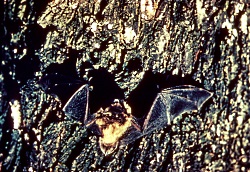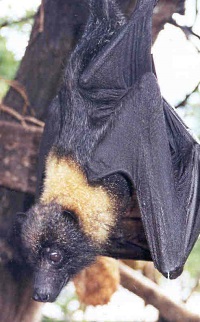
Courtesy US National Park Service
Utah is home to eighteen species of bats found throughout the state which roost in a variety of habitats including caves, mines, hollow trees, leafy plants, rock cliffs, and buildings. The big free-tailed is the largest in Utah with a wingspan of 17 inches weighing less than an oz. The smallest bat, the western pipistrelle, is the size of a hummingbird and weighs 1/10 oz.
Most Utah bat species are year-round residents hibernating during the winter. Some species migrate south and remain active all year while migrating species breed in the spring. Hibernating bats usually breed in the fall. In the late spring, female bats gather in large nursery colonies where their young, called pups, are born in May or June.
Bats have “slow” life history and are constrained by tight energy budgets. Energetics has emerged as a driver of extinction risk among North American bats. Some of the most wide-ranging species are now on an accelerated trajectory toward extinction as a result of disease and wind energy production. Climate change is also likely to impact many bat species with broad ranges. Urbanization and other kinds of habitat-fragmenting land use changes are also thought to be altering species distribution patterns.
Bats offer many ecosystem benefits. Some subtropic species pollinate plants, many serve as prey to other animals, and cave communities benefit from bat guano which provides nutrients.
Bats benefit humans by eating up to 100 percent of their body weight in insects each night (1000 insects/hour), providing over $3.7 billion worth of pest control each year in the U.S. and reducing the need for pesticides. Their membrane wings and echolocation have inspired technological advances in engineering. The wingsuits used by basejumpers take more than a few cues from bats’ aerodynamic bodies. Utah law protects all bat species. Additional federal protection is extended to species on the Endangered Species List.
Given many gifts bats provide for humans numerous ecosystem services, we can reciprocate by reducing outdoor lighting which disrupts their natural behaviors, avoid disturbing them, especially if they are hibernating, building a bat house, and participating in Bat Week which occurs the last week of October. It’s a time to celebrate and learn about our Utah bats!
Jack Greene for Bridgerland Audubon Society and I’m Wild About Utah bats!
Credits:
Images: Courtesy US FWS, USDA Forest Service and US NPS. All photographers acknowledged with images
Featured Audio: Courtesy & © Friend Weller, https://upr.org/
Text: Jack Greene, Bridgerland Audubon, https://bridgerlandaudubon.org/
Additional Reading Links: Jack Greene & Lyle Bingham, https://bridgerlandaudubon.org/
Additional Reading:
Wild About Utah Pieces by Jack Greene, https://wildaboututah.org/author/jack/
Strand, Holly, Bats and Echolocation, Wild About Utah, May 13, 2010, https://wildaboututah.org/bats-and-echolocation/
Bunkley, Jessie, Bat Netting at Antelope Island State Park, Wild About Utah, July 11, 2016, https://wildaboututah.org/bat-netting-at-antelope-island-state-park/
Bats, Wild Aware Utah, https://www.wildawareutah.org/wildlife/bats/
Thomas J. Rodhouse, Thomas E. Philippi, William B. Monahan, Kevin T. Castle, A macroecological perspective on strategic bat conservation in the U.S. National Park Service, Ecosphere, ESA, https://esajournals.onlinelibrary.wiley.com/doi/full/10.1002/ecs2.1576
Animal Fact Sheet: Western pipistrelle bat, Arizona-Sonora Desert Museum, https://www.desertmuseum.org/kids/bats/western_pipistrelle.php
Discover the Secret Lives of Bats, National Park Service, https://www.nps.gov/subjects/bats/index.htm
Bat Species in Parks, National Park Service, https://www.nps.gov/subjects/bats/bat-species-in-parks.htm
16 Incredible Pictures Show the Beauty of Bats, National Geographic, https://www.nationalgeographic.com/animals/article/incredible-photos-bat-appreciation-day
Utah’s 18 Bats, Utah Species, Fieldguide.Wildlife.Utah.gov, Utah Division of Wildlife Resources, https://fieldguide.wildlife.utah.gov/?order=chiroptera
- Big Free-tailed Bat – Nyctinomops macrotis, https://fieldguide.wildlife.utah.gov/?species=nyctinomops%20macrotis
- Brazilian Free-tailed Bat – Tadarida brasiliensis, https://fieldguide.wildlife.utah.gov/?species=tadarida%20brasiliensis
- Allen’s Big-eared Bat – Idionycteris phyllotis, https://fieldguide.wildlife.utah.gov/?species=idionycteris%20phyllotis
- Big Brown Bat – Eptesicus fuscus, https://fieldguide.wildlife.utah.gov/?species=eptesicus%20fuscus
- California Myotis – Myotis californicus, https://fieldguide.wildlife.utah.gov/?species=myotis%20californicus
- Canyon Bat – Parastrellus hesperus, https://fieldguide.wildlife.utah.gov/?species=parastrellus%20hesperus
- Fringed Myotis – Myotis thysanodes, https://fieldguide.wildlife.utah.gov/?species=myotis%20thysanodes
- Hoary Bat – Lasiurus cinereus, https://fieldguide.wildlife.utah.gov/?species=lasiurus%20cinereus
- Little Brown Myotis a.k.a. Little Brown Bat – Myotis lucifugus, https://fieldguide.wildlife.utah.gov/?species=myotis%20lucifugus
- Long-eared Myotis – Myotis evotis, https://fieldguide.wildlife.utah.gov/?species=myotis%20evotis
- Long-legged Myotis – Myotis volans, https://fieldguide.wildlife.utah.gov/?species=myotis%20volans
- Pallid Bat – Antrozous pallidus, https://fieldguide.wildlife.utah.gov/?species=antrozous%20pallidus
- Silver-haired Bat – Lasionycteris noctivagans, https://fieldguide.wildlife.utah.gov/?species=lasionycteris%20noctivagans
- Spotted Bat – Euderma maculatum, https://fieldguide.wildlife.utah.gov/?species=euderma%20maculatum
- Townsend’s Big-eared Bat – Corynorhinus townsendii, https://fieldguide.wildlife.utah.gov/?species=corynorhinus%20townsendii
- Western Red Bat – Lasiurus blossevillii, https://fieldguide.wildlife.utah.gov/?species=lasiurus%20blossevillii
- Western Small-footed Myotis – Myotis ciliolabrum, https://fieldguide.wildlife.utah.gov/?species=myotis%20ciliolabrum
- Yuma Myotis – Myotis yumanensis, https://fieldguide.wildlife.utah.gov/?species=myotis%20yumanensis
White-nose syndrome: a disease of bats, Wildlife Blog, Utah Division of Wildlife Resources, https://wildlife.utah.gov/news/wildlife-blog/724-white-nose-syndrome-a-disease-of-bats.html
Building nurseries for big-eared bats, Wildlife Blog, Utah Division of Wildlife Resources, https://wildlife.utah.gov/news/wildlife-blog/707-building-nurseries-for-big-eared-bats.html
Rush, Claire, It’s almost Halloween. That means it’s time for a bat beauty contest, The Associated Press, October 26, 2024, https://apnews.com/article/bat-beauty-contest-bureau-of-land-management-6fb06024c8063903c73da3eaae2449a1









